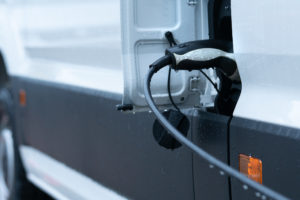The transition to electric vehicles is a vital stretch on the road to climate sustainability. But it’s also a smart and rational move in ensuring business sustainability.
The road to sustainability is a bumpy one, full of hairpin turns and potentially treacherous terrain. The destination (net zero) is on the horizon but getting there will take some canny navigation. And some big changes.
Anything disruptive or revolutionary that challenges the status quo is complicated. The same goes for EV transition. Many factors are at play when redesigning the energy sector, resources and infrastructure for electrified transportation — and keeping it green. There’s also conflict. The push and pull between the yea-sayers and the naysayers — governments, countries, lobbyists, activists corporations and industries — is immense.
So, it’s no wonder people are unsure (confused, skeptical, uninformed…) about how, when or if to move forward with EV transition and still maintain profitable business continuity.
Similar thoughts might be going through your mind too. The subject has certainly become a frequent topic in the daily press. Consider these quotes from a recent Guardian article.
Alistair Phillips-Davies, chief executive of big six energy company, SSE:
“Net zero is not only an environmental decision, it’s a rational economic one. Investing now will not only reduce our future exposure to gas markets but it will also support jobs and growth.”
Or from leading UK Conservative environmentalist Zac Goldsmith:
“Ninety per cent of the global economy is committed to net zero. The politics is clear … Choosing to be the outlier would be insane.”
A tipping-point in public opinion
By now it seems we can all agree that the planet is going through a climate crisis. Add yet another geopolitical crisis driven by oil & gas and the case for sustainable solutions becomes even more relevant. A panoply of kids, activists, scientists, futurists, entrepreneurs and politicians seem to have finally gotten the message across.
All these things together have caused a tipping-point in public opinion.
What are the greatest advantages of transitioning to electric vehicles? This is a question we recently asked in a survey of fleet managers across Germany. Top answer: environmental sustainability. You’ll find that answer topping the list of most any poll about the advantages of e-transition.
Yet one third of fleet managers in that same PANION survey saw no advantages whatsoever in electrification. Confused yet? Let’s clarify. The “no advantages” camp of fleet managers polled are likely still concerned by the fear memes of EVs. Namely, range anxiety, insufficient charging infrastructure and high e-transition costs of ownership. Most of which are more myth than fact.
Net zero goals are set, incentives to electrify are widespread, and e-mobility technology and infrastructure is accelerating. The time has never been better for EV transition. Yet, people are still in doubt. And doubt causes complacency. Complacent people don’t act.
Some are content to wait until the last minute. Some hope the status quo will remain. Others are just actively trying to disrupt the disruption.
But the smart ones are taking advantage of the advantages.
EV transition on the road to sustainability
2030 is coming. The race to electrify is on. This is what climate sustainability needs — and it’s finally happening. But in truth, it’s the Institutionalization of legal agreements across the world that is driving the transition. Projected bans on ICE vehicles and oil and gas drilling, or carbon offset pricing are realities that won’t just fizzle out.
The point is that it has taken a deadline of sorts — the international consortium of net zero targets and eco-laws — to get the sustainability ball rolling. Still complacent? Tough luck, get with the program buddy or be left behind. Even if it seems unfair, a deadline is exactly what the world needed. Too bad it took so long, but hey.
This is where the race to electrify becomes a business case. This is where sustainability starts meaning business sustainability too.
No matter which camp you sit in, coming to terms with how and when to electrify is a smart and pragmatic business decision.
ElectROIfication of fleets
Is there value in fleet electrification? Is the ROI realistic? That’s what matters at the end of the business day. The advantages of moving forward with EVs and electrifying fleets certainly outweigh the risks. But to take advantage of the advantages of EV transition, the time to act is now.
Incentives are value propositions in themselves, and governments offer a few attractive ones. But subsidies and tax breaks won’t be around forever.
- EV subsidies
- Tax exemptions
- Registration fee exemptions
- Charging station subsidies
- Free parking allowances
Advantages like those are only being offered for another couple years. France currently offers up to €12,000 on EV purchases. Incentives, for example in Germany (at up to €9,000), are projected to be phased-out in 2025 — but a new program has just been announced lasting through 2028. China has been lowering incentives since 2018, but they now have the largest EV market share globally. The US is a bit behind on incentives, until (and if) more of Biden’s climate and EV-related legislation goes through.
The advantages don’t end there…
- Lower total cost of ownership (TCO)
- Comfort & safety
- Digitalization & data
- Positive image/reputation
- Saving the planet
It’s true that right now the initial investment for EVs to electrify your fleet is higher. Down the road though, a nice TCO with lower operating costs, better mileage, less maintenance and cheaper fuel/energy will pay off.
The future is electrifying
Still thinking about that cold hard cash? Consider these tidbits of information.
- Carbon offsetting currently runs around €50/ton. By 2030, this will almost double.
- Access to many metropolitan centers will be EV only by 2030.
- Additional fees for vehicles producing high CO2 emissions (feebate).
- Let’s not even talk about oil & gas.
Gargantuan investment is still needed to reach net zero. Further technological development also must happen. The wrinkles in electrification infrastructure still exist. But the problems are identified, and the solutions are known — and they work. That’s a good value proposition. That’s futureproofing. Let’s call it smart climate and business sustainability.
And the best part? We’ll have a chance to live on a cleaner greener planet.
Time to electrify!




